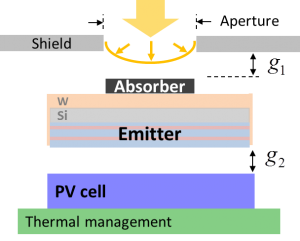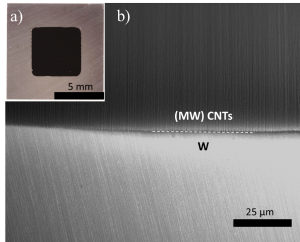Optimizing Emitter-to-Absorber Area Ratio for Improved Efficiency in Planar Solar Thermophotovoltaics
- Category: Energy, Materials, Optics & Photonics
- Tags: andrej lenert, evelyn wang
Solar thermophotovoltaic (STPV) devices have the potential to overcome the Shockley-Queisser limit by converting solar radiation to a narrow-band thermal emission matched to the spectral response of a photovoltaic (PV) cell[1],[2]. However, limiting the influence of non-idealities of the individual STPV components (absorber/emitter/PV) through an understanding of the highly coupled energy conversion process is needed to approach high efficiencies. Although reported TPV efficiencies (thermal-to-electric) have exceeded 10%[3], measured overall STPV conversion efficiencies are below 1%[4],[5]. One of the most prohibitive aspects of this system can be the thermal transfer efficiency due to the high temperature operation of the device.
In this work, we designed an experimental system for characterizing high-temperature planar STPVs, schematically shown in Figure 1, aimed to bridge the gap between potential and measured STPV performance. We show how increasing the emitter-to-absorber area ratio (AR) can compensate for non-ideal spectral selectivity on the absorber side. This concept was implemented in planar devices through a process of seeded growth of vertically aligned multi-walled carbon nanotube forests on smooth tungsten surfaces (shown in Figure 2). The TPV-side of the system is composed of a one-dimensional Si/SiO2 photonic crystal emitter (1D PhC) paired with a low band-gap PV cell (InGaAsSb). With a 4:1 emitter-to-absorber area ratio (AR 4), we experimentally demonstrate a two-fold increase in thermal transfer efficiency (relative to AR 1) and a significant boost in STPV performance leading to efficiencies exceeding 2%.
- Figure 1: Schematic of the planar STPV experimental layout. Incoming solar radiation is converted to heat at the absorber (MWCNT/W); heat is selectively radiated by the emitter (1D PhC) and converted to electrical power at the PV (InGaAsSb – 0.55 eV).
- Figure 2: a) Absorber-side top view of a 4:1 emitter-to-absorber module showing spatially-defined MWCNT growth on a W-coated Si substrate. b) SEM side view of the MWCNT/W boundary, showing the vertically aligned nanotubes.
- H. Nils-Peter and W. Peter, “Theoretical limits of thermophotovoltaic solar energy conversion,” Semicond. Sci. Technol. , vol. 18, no. 5, pp. 151-157, 2003. [↩]
- W. Shockley and H.J. Queisser, “Detailed Balance Limit of Efficiency of p-n Junction Solar Cells,” J. Appl. Phys., vol. 32, no. 3, pp. 510-519, 1961. [↩]
- C.J. Crowley, N. A. Elkouh, S. Murray, and D. L. Chubb, “Thermophotovoltaic Converter Performance for Radioisotope Power Systems,” in AIP Conf. Proc., 2005, vol. 746, pp. 601-614. [↩]
- A.S. Vlasov et al., “TPV Systems with Solar Powered Tungsten Emitters,” in AIP Conf. Proc., 2007, vol. 890, pp. 327-334. [↩]
- A. Datas and C. Algora, “Development and experimental evaluation of a complete solar thermophotovoltaic system,” Prog. Photovolt: Res. Appl., Available: doi: 10.1002/pip.2201 [↩]

